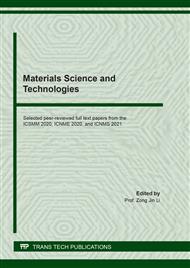p.105
p.111
p.116
p.125
p.131
p.137
p.143
p.150
p.167
Synthesis of Polylactic Acid/Cellulose Composite Extracted from Pineapple Leaves
Abstract:
In this work, cellulose was extracted from pineapple leaves by basic hydrolysis and surface-modified by silane coupling agent (Si-69) for use as reinforcing agent in polylactic acid (PLA). The pineapple leaves were subjected to alkali and bleaching treatments to remove hemicellulose and lignin. The corresponding FTIR spectra reveals intensity peaks at 1727 cm-1 assigned to C=O stretching in hemicellulose, 1614 cm-1 and 1539 cm-1 from C=C stretching of lignin and 1241 cm-1 attributed to C-O stretching of lignin, all of which decreased following the chemical treatments to confirm the effective removal of hemicellulose and lignin. These results were consistent with fiber composition analysis where hemicellulose and lignin both favorably decreased from approximately 20% to 5.46% and 0.47%, respectively, after chemical treatments. However, cellulose content unfortunately also decreased with bleaching cycles despite improving the cellulose yield. The cellulose was effectively surface-modified by 5 wt% and 10 wt% of Si-69 as confirmed with C-O-Si stretching at 1240 cm-1 from FTIR. As a reinforcing filler to improve PLA performance, cellulose treated by Si-69 were infused into PLA matrix to obtain composite films by solvent casting. As expected, PLA modified with surface-modified cellulose showed the highest value of tensile strength of 21.75 Mpa among the reinforced filler samples and pure PLA, due to a strong adhesion at the interphase of PLA matrix and cellulose.
Info:
Periodical:
Pages:
131-136
Citation:
Online since:
July 2021
Keywords:
Price:
Сopyright:
© 2021 Trans Tech Publications Ltd. All Rights Reserved
Share:
Citation:


